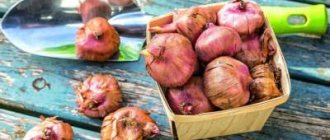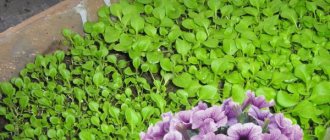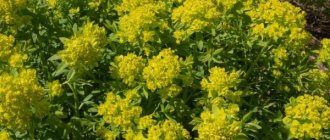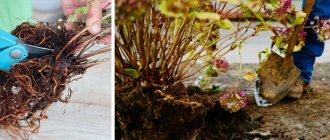Reproduction, planting and transplantation of cineraria
The methods of propagation of cineraria depend on its species:
- Flowering species reproduce exclusively by seeds.
- Decorative foliage species can be obtained from seeds and cuttings.
- Indoor cineraria can be propagated by seeds and by dividing the bush.
Sowing of seeds of flowering species occurs from December to February. If the seeds were sown in February, the flower will release buds only closer to autumn.
The decorative deciduous species can be sown even in March. Then in May the flower will take on the appearance of a beautiful bush.
Growing from seeds involves the following steps:
- For flowers, select a wide, shallow container with good drainage holes.
- For seeds, prepare special soil consisting of peat and sand in equal proportions.
- The seeds are carefully distributed over moist soil, leaving a distance of about 2 cm between the seedlings. Densely planted flowers will be difficult to pick. After distribution, they are lightly submerged. To do this, you can use a regular stationery ruler.
- The container is covered with film or glass. It is placed in a room with an air temperature of 20℃-22℃.
- Seedlings should be ventilated and the soil sprayed every day. The first shoots will appear after 1.5 weeks.
- The sprouts are planted in peat pots and moved to a cool room with a temperature no higher than 15℃.
- With the onset of stable warmth, the sprouts along with peat pots are transplanted to the site. In open ground they are cared for like adult plants.
Decorative deciduous varieties can be cut from:
- In summer, shoots about 10 cm in length are cut from the flower.
- For better rooting, before planting, they are treated with the drug Kornevin, which stimulates root growth.
- The cuttings are stuck into a damp sand-peat mixture under a cap. If such caps are not found on the farm, they can be replaced with cut-off transparent plastic bottles.
- The cuttings are ventilated and moistened daily.
- After rooting, the caps are removed.
- The shoots remain in sandy-peaty soil until spring.
- For the winter they are moved to a cool place.
- With the onset of warm weather, rooted cuttings can be planted in plots.
Cuttings
The indoor species can be propagated by dividing the bush; this is usually done during transplantation:
Using a sharp sterile instrument, the rhizome of the plant is cut into the required number of parts.
It is very important that each separated part has at least 1 strong stem. The damaged areas are treated with an antiseptic. Each part of the bush is placed in a separate pot.
Indoor flower replanting is carried out in the spring, before the budding process begins. The plant does not need to be replanted annually. It is enough to replace the soil every 2-3 years. The soil for the flower should consist of leaf soil, compost and peat. It is advisable to add a little pine bark and ash there. Medium-sized pots are selected for cineraria.
Garden flowers, which are grown as perennials, are transplanted into a pot every fall and returned to the plots in the spring. Before planting, the soil must be dug up, enriched with a small amount of peat, sand and compost. The holes for cineraria are made shallow, and the flowers themselves are planted at a distance of 20-25 cm from each other. After planting, the soil is abundantly moistened and mulched with peat.
It will also be interesting: Tradescantia Reo - flower care at home and types?
How to properly plant seaside cineraria for seedlings
Proper planting of silver cineraria for seedlings at home is not only sowing seeds, but also choosing suitable soil, containers, and preparing seed material. And each sowing step has its own tricks and nuances.
Seed preparation
Seaside cineraria seeds can be sown as seedlings without preparation. However, if you soak it in a solution of a growth stimulator (for example, in the preparation Zircon, Epin-Extra), then germination will improve and you will generally see more friendly shoots.
Soil preparation
Silver cineraria seedlings will be most comfortable in loose, light, fertile soil. You can plant seeds in ordinary universal soil for seedlings. But if it turns out to be too dense, it is recommended to add a loosening element to it, for example, sand, vermiculite, perlite.
If you want to make your own soil mixture, you can mix the following ingredients: turf soil (2 parts), peat (1 part), sand (1 part).
Selection of capacity
A wide and not very deep bowl, approximately 8-10 centimeters high, is ideal. This can be either a special box for seedlings, or a regular food container, or some other container.
You can sow cineraria seeds for seedlings in cups or cassettes. But it’s still convenient to first put them in a common box and then dive.
The container for seedlings must have drainage holes to remove excess moisture. If they are not there, then you need to do it yourself, for example, with a nail, soldering iron, scissors.
Master class on sowing
The following instructions with step-by-step photographs will help you correctly plant silver cineraria seeds for seedlings:
1) Fill the bottom of the container with drainage.
You can use expanded clay, perlite, broken brick. The optimal size of the drainage layer is 1.5-2 cm.
2) Fill the container with soil.
It is necessary to distribute the soil evenly to avoid the formation of voids and unevenness. Leave a small distance to the edges of the container, about 2-3 centimeters.
3) Moisten the soil generously.
4) Sow.
As you can see in the photo, the seeds of silver cineraria are not very large:
Due to their small size and lightness, it is most convenient to sow with a wooden toothpick. Dip one end of the toothpick in water; the moisture will allow the seed to stick to it easily.
Bring the end to the seed and pick up one seed:
Plant it in the ground, lightly wiping the end of a toothpick on the surface of the ground. Or you can bring the product to the ground and brush off the seed with another toothpick.
You can also sow with your fingers, as if adding salt:
5) Water after planting.
This should be done from a spray bottle. Thanks to it, the moisture will be distributed most evenly and the seeds will not be buried under the pressure of water.
6) Cover the container with a lid or film to create a mini-greenhouse.
7) Label the seedlings so as not to confuse them with other plants.
Reproduction
Since our climate differs from the tropical one, cineraria has to be grown from seedlings. It is almost impossible to create ideal conditions for proper germination of seeds in open ground.
Note! The only variety that can be sown in the garden is cineraria graceana. Deciduous forms are propagated by cuttings, decorative flowering ones are propagated by seeds.
How to grow from seeds?
Seeds of silver cineraria (perennial or annual - depending on growing conditions) are purchased at a flower shop. Germination is usually not satisfactory. It is recommended to sow ashy ragwort for seedlings in April.
- Fill the container with a mixture of sand and peat in a 1:1 ratio.
- There is no need to deepen the seeds. It is enough to sow them on the surface and lightly tamp them with a wooden ruler.
- Using a sprayer, moisten the soil.
- Cover with glass.
Seedling care
The appearance of seedlings should be expected after 10 days. The container with the finished sprouts is transferred to a lighted place. As soon as 2 full-fledged leaves appear, make a pick. To do this, the plant is taken out of the container along with the soil and transplanted into a suitable container. A good option would be peat briquettes.
Before replanting the Cineraria Silverdust plant or any other species, choose a well-lit place in the garden bed. It is advisable that at noon there is light partial shade. Neutral soil, saturated with useful elements, is suitable. It is better to plant in mid-May, when the likelihood of frost is almost zero. The technology for planting in open ground and further care is almost no different from other plants.
The recommended distance is 20-25 centimeters. The bush is removed along with a lump of earth and placed in a hole. Then lightly compact the soil and water it. If there is still a chance of frost, cover the plants with spunbond overnight and remove them in the morning.
How to propagate by cuttings?
The seaside species is propagated by cuttings. Prepare a portable box, the so-called “cutting box,” into which the cuttings will be planted. It is made independently from boards and plywood, drainage holes are made.
Primorskaya cineraria
- The soil is garden soil mixed with sand. It is laid on the bottom 10 centimeters thick.
- The next layer is coarse sand, the recommended layer thickness is 6-7 centimeters.
- First, the surface is leveled and sprayed with a solution of potassium permanganate.
- Each section is treated with root and immersed in the prepared substrate. Lightly tamp, cover with a plastic bottle, which can be removed only after complete rooting.
- Water 2 times a day. Gradually remove the cover for 1-2 hours, and then forever.
- For the winter they are placed in a cool room - cellar, basement. In spring you can plant it in a flower bed.
Proper watering
One of the strengths of the culture is drought resistance. Thanks to this feature, cineraria (ragus) can be considered a real masterpiece for flower beds, public parks and gardens. Natural precipitation is often sufficient. But during periods of severe drought, the decorative value of plantings can be significantly reduced. The leaves turn yellow and wither. Since cineraria does not bloom so profusely without watering, additional moisture is recommended. It is desirable that it be at the roots, and the water should be warm and settled. Water between rows, loosen the soil and remove weeds.
Note! Of course, moderation must be observed. Too swampy soil leads to the appearance of fungus
The roots begin to rot and the bushes die.
Rules of care
In addition to watering and loosening the soil, it is recommended to regularly pick off wilted flowers. Then cineraria diamond powder will bloom much longer.
Do I need to feed the plant? Undoubtedly. Fertilizing is carried out 2-3 times a month, mineral fertilizer is used. If decorative flowering species grow in a flowerbed or in pots, they are fertilized more often - once a week. Alternate organic and mineral fertilizers.
Types and varieties of cineraria with photos and names
All types of cineraria used in gardening are divided into plants with decorative foliage and beautiful flowers. The former are most often grown in gardens, while the latter can serve as indoor plants.
Seaside cineraria (cineraria maritima)
Or cineraria silver, silvery. This species is also known as sea grass. It belongs to the decorative deciduous species. Cineraria maritima is a perennial that forms a rosette of spectacular cut plates. They are remarkable for their greenish-silver color and look unusually elegant in flower beds. Due to the characteristic color and compact size of the bushes, this cineraria is often used in the design of ridges, flower beds and rockeries, as well as to create various flower arrangements. It favorably emphasizes plantings with bright flowers or leaves. Low-growing varieties are most often used as border plantings.
This type of cineraria can also bloom - this usually happens in the second year of cultivation. At the same time, the species forms unremarkable yellow daisy flowers of small size. So that the bushes do not waste energy on forming flowers, and their color does not disturb the color scheme of the foliage, many gardeners remove the inflorescences after they form. Popular varieties include:
- Silver Dust - forms small (about 25 cm) neat bushes with openwork silvery foliage.
- Cirrus is distinguished by larger bushes (about 45 cm) in size with jagged leaf blades of an unusual oval shape. The older the bush is, the lighter foliage it will have.
Hybrid cineraria (Cineraria hybrid)
Or cineraria is red and bloody. This species belongs to the decorative flowering species. Cineraria hybrid forms low (from 30 cm) bushes with large rounded foliage. Its length is about 15 cm. Brightly colored inflorescences appear against the background of green leaves. They are shaped like daisies or daisies. The species is most often grown in pots due to the long growing season: the bushes bloom only 8 months after sowing. To get flowering plants by summer, you should sow them as seedlings in winter - in December. The bush will delight you with its baskets for about a month. Among the most common varieties:
- Grandiflora - bushes up to 70 cm tall with large flowers up to 8 cm in size.
- Double - the height of the bushes varies from 35 to 70 cm, the size of the flowers is about 5 cm.
- Stellata is a tall variety (up to 90 cm) with small (about 3 cm) flowers resembling stars.
- Sympathy - the flowers of this variety can have a two-color color.
Elegant Cineraria (Senecio elegans)
A South African species that forms branched stems up to 60 cm high. They, like the foliage of the bush, are covered with sticky pubescence. Senecio elegans can have simple or terry baskets collected in scutes. The flowers remain on the bushes until the onset of autumn frosts. This species is less decorative, but attracts gardeners with its unpretentiousness and blooms earlier than the hybrid cineraria. Formative pruning will help make flowering more abundant, adding fullness to the bushes. Among the main varieties:
- Ligulosus is a variety with terry baskets of different shades.
- Nanus are dwarf plants about 25 cm high.
Garden flowers Annual and biennial flowers
Cineraria - home care
Special rules have been developed for keeping cineraria in a pot and caring for seedlings and adult plants in open ground. It has been noted that good bud formation occurs at temperatures up to 12°C. At midday, sunburn may form on the foliage, so it is advisable to grow the plant in diffused light. For indoor forms, medium-sized pots are used. The soil is prepared from a mixture of peat, leaf soil and completely rotted compost.
Features of caring for cineraria flowers:
- When keeping a flower indoors, you need to humidify the air with devices or use open containers with water.
- The plant does not like fresh organic matter; the soil in the flower beds is prepared in the fall.
- In the spring, nitrogen fertilizers or mullein are applied, and on the eve of flowering, phosphorus fertilizers are applied.
- Fading inflorescences are cut back to the first leaf.
- You can shorten long retracted shoots on bushes.
- In open ground, use mulch to protect against drought.
- In the fall, the cineraria is removed or dug up and replanted in a pot; in winter, such bushes need to be kept at temperatures up to 15°C.
- In the South, cineraria can be grown as a perennial, covering the flowers from frost with spruce branches or other material.
Cineraria - transplantation after purchase
The problem of when to replant cineraria grown from seedlings must be solved in late spring. For indoor forms, soil made from sand, leaf and turf soil, mixed in equal proportions, is used. In stores they sell adult bushes in separate pots with a diameter of 10 cm with a large number of unopened buds. These flowers do not need additional replanting. When transplanting into a flower bed, the holes are placed at a distance of up to 25 cm. The earth is watered, compacted a little and covered with mulching material.
Cineraria - watering
An important question when growing cineraria in pots: “How to water capricious plants?” Water should be used that is settled and warm. We try not to wet the fuzzy leaves, so we pour the liquid under the root. In hot weather, watering can be done even twice a day, but do not let the water stagnate. To improve air exchange, we periodically loosen the soil. It is recommended to sprinkle the top soil with a thin layer of expanded clay, which helps to avoid drying out of the soil.
Cineraria diseases
The problem of why cineraria leaves wither can arise due to several reasons. A common disease of this flower is powdery mildew. Its occurrence is provoked by improper watering, which leads to an excess of moisture in the soil. It is better to remove infected cineraria from the flowerbed. The leaves of an indoor flowerpot may wilt if kept in a hot room with dry air. If flowers are affected by spider mites or aphids, then the plants need to be treated with insecticides.
Cineraria after flowering
Most often in mid-latitudes, cineraria is used as an annual plant. In this case, in late autumn, its bushes are simply removed from the beds. But you can try to save species with beautiful leaves until next season. To do this, they are cut to a level of 15 cm, and then they try to insulate them by filling the flowerbed with a layer of fallen leaves and spruce branches. Bushes should be covered a couple of weeks before snow cover sets in. In the spring, as soon as the snow melts, the leaves are removed from the bushes and carefully inspected, removing frozen areas of the bushes. This is done so that they do not interfere with the development of fresh growth.
Another way to overwinter cineraria: transplanting it into a pot. The dug bush is moved into a pot and then put away in a bright but cool place. Watering is carried out only as needed, without allowing the soil to dry out completely. In the spring, such cineraria is simply returned to the ground with the arrival of suitable weather.
Coastal cineraria branches pruned in autumn can be used to form a dry bouquet.
Use in landscape design
This culture is in demand as the main background when creating various kinds of flower arrangements in the garden. Most often, silver bushes are rooted together with bright and flowering garden plants on alpine hills and in stone gardens.
Silver cineraria can also be used to create original patterns in large areas of the garden. The culture combines harmoniously with orange or red flowers.
Gardeners prefer to combine the whitish foliage of the shrub with bright colors; in addition, the culture beautifully complements delicate white or pink flowers.
In addition to group plantings, ragwort in landscape design is found as single plantings in the form of an openwork carpet, which will look laconic and attractive in the flowering phase, before and after it.
You can learn more about the rules for growing silver cineraria from the video below.
Popular types
The Cineraria genus is conventionally divided into 2 groups:
- Decorative foliage. It has silvery flowers and leaves and is usually grown outdoors.
- Decorative blooming. Valued for its dense, voluminous bouquet of flowers, used for room decoration.
One of the common species is silver cineraria. Sometimes it is called graceful ragwort or graceful cineraria, as well as seaside, ashy. The birthplace of culture is the Mediterranean. It has almost white foliage. It is used in landscape design as a border planting. The flowers are small and have no aesthetic value. Some gardeners intentionally remove them at the budding stage.
- Silver dust. Characterized by graceful carved leaves and low growth. Used to create a background for other garden plants.
Silver - Andromeda. A medium-sized species of ashy ragwort up to 40 centimeters high. With age, it changes color from green to silvery white.
- Bloody or hybrid. There are dozens of spectacular hybrids that form a bright bouquet. In most cases, it is grown as an indoor crop, although it was brought to us from the Canary Islands. If planted in open ground, it will grow well as an annual. Retains decorative effect for 2-3 months. Wide range of colors - from soft pink to deep purple.
- Cineraria graceful is another prominent representative of the genus. Although it is inferior to its relatives in terms of decorativeness, it is the most unpretentious plant.
Varieties
Among the available varieties of ragwort, it is worth highlighting the most popular ones.
"Silver will give"
Decorative crop, with a pronounced lacy appearance of leaves. Silver Dust are small bushes with dense pubescence that become more attractive as they grow. The green mass of the variety is carved, the culture will be velvety to the touch, and the color will be silver. The plant is very often used by amateur gardeners and landscape designers.
Cineraria bloody
A variety of universal type that requires special care, since the shrub goes through a rather long growing season. The decorative appeal of the plant is emphasized by small snow-white inflorescences with a red border. Planting of the crop is usually carried out in winter or early spring.
"Stelata"
A hybrid variety of ragwort. Cineraria bloody was used as the mother culture of this plant. Among the expressive differences of the new bush, it is worth highlighting a different color of the inflorescences - an indigo shade. On average, the shrub is capable of growing in height up to 70 centimeters, while the crop creates an attractive carpet of large leaves on the ground.
"Nana"
This shrub attracts gardeners due to the presence of beautiful inflorescences that look like chamomile. In addition, the decorative appeal is complemented by the color of the flowers, which are distinguished by a burgundy center and deep pink petals.
Varietal diversity of Cineraria
Among the varietal diversity, there are several that are most popular:
- Cineraria Primorica "Silver Dust". Perennial. Visually it looks like a low-growing bush, the maximum height of which can reach 40 cm. It has powerful, well-branched shoots that form a furry crown. The foliage is silvery-white and slightly pubescent.
- "Silver Falls" An annual representative of the species, distinguished by its miniature size. The height of the bush reaches 25 cm. The branches are widely branched, the foliage is openwork, silver-white in color.
- "Cirrus." Young shoots have a greenish-whitish tint, which changes to metallic with age. The bush reaches 45 in height and has a well-developed crown.
Growing cineraria from seeds
The best way to obtain a cineraria plant is to grow it from seeds. When to plant them depends on the climatic conditions of your region of residence.
To grow seedlings from seeds, it is better to purchase them in specialized stores. The seeds have a high germination rate.
Sowing can begin in the first days of April. To do this, you will need a container with a substrate - a mixture of peat and sand in a 1:1 ratio. The seeds do not bury the soil, but are left on the surface. After they are sown, the soil is slightly leveled with a small wooden ruler. The soil needs to be watered using a sprayer or by placing the container in a tray with water. The container with future seedlings is covered with glass on top.
A week later, the first seedlings already appear. At this time, the container should be moved to a well-lit place. After the young plants have thrown out 2 true leaves, you can pick them and plant them in separate pots. To do this, the plants are removed from the container along with a small lump of earth. Briquettes with a mixture of peat and humus are best suited as a substrate. It will be much easier to transplant them into open ground.
Pests and diseases
In general, cineraria is considered to be very resistant to diseases and pests. But species with decorative foliage can be affected by powdery mildew. In hot, humid weather they can also develop rust, and overwatering often leads to the development of rot or mold. Sometimes cineraria are harmed by aphids or spider mites.
Due to the presence of pubescence on the foliage, it can be difficult to combat such problems by spraying, so it is easier to prevent diseases caused by decreased plant immunity. Systemic insecticides will help against pests.
Caring for cineraria at home and in the open ground
Caring for flowering and decorative deciduous varieties is no different. In addition to standard care for cineraria, growing Silver varieties involves systematic pruning of shoots. Without pruning, the plant looks unkempt and neglected.
Lighting
Cineraria loves bright light. Such lighting is provided to her in the first half of the day, and after 12 o’clock it is shaded. The need is due to the detrimental effect of the midday sun on the flower: direct rays of the scorching sun hitting the plant lead to burns.
Cineraria can grow calmly in a darkened area, but in such conditions it loses its decorative appearance.
Garden flowers are planted in areas where the sun does not reach after 12. Indoor plants are placed on western and eastern window sills.
Temperature and humidity
The flower is very demanding in maintaining temperature conditions. Temperature surges are contraindicated for him. Despite the fact that the plant’s homeland is hot countries, cineraria prefers cool conditions. The optimal temperature for keeping it is considered to be from 15℃ to 18℃. In a hot room, the shoots of the flower droop and wither.
The critical minimum temperature for a plant is +5℃. In colder air the flower freezes. A prerequisite for growing Cineraria is a constant flow of fresh air. A flower does not live in a musty room.
Cineraria likes air with high levels of humidity.
However, the standard measure of increasing it in the form of spraying is not suitable due to the hairiness of the stems and leaves of the plant. You can only spray the air around the plant. To increase the level of humidity, indoor flowers are placed on trays with wet materials: pebbles, expanded clay.
They are also placed next to aquariums and household humidifiers. The soil around garden plants is heavily moistened to allow moisture to evaporate. It is necessary to water the soil away from the root so that the flower does not rot.
Watering and fertilizing
Cineraria requires abundant and regular watering. The indoor species is watered through a tray, draining excess water after a while. Garden varieties are moistened at the root more often, but in small doses. The optimal scheme for watering garden cineraria is as follows:
- growing season: 0.5 l every 2 days;
- bud formation and flowering period: 0.3 l every day.
For irrigation use soft, settled water. After moistening, the top layer must be fluffed. Indoor varieties must be periodically cleaned from dust. To do this, they are given a shower under warm running water.
After this procedure, excess moisture is removed from the leaves using a towel. You cannot leave a wet flower in the sun because of the risk of getting burned.
The plant is fed 2 times a month. Balanced feeding for cineraria involves alternating mineral fertilizers with organic ones. To do this, use complex mineral fertilizers for flowering plants (or for ornamental ones, depending on the type) and mullein. In spring, the flower needs an increased concentration of nitrogen, and during budding and flowering - phosphorus. When planting and replanting plants, compost must be added to the soil.
Preparing for winter
Caring for indoor cineraria in winter is no different from regular care. The only requirement is to reduce the air temperature to 10℃-15℃. With garden species the situation is different.
In areas with moderately warm winters, they are left in the open ground, well covered with coniferous spruce branches or dry fallen leaves.
The cover layer should be at least 15 cm. If the winter is expected to be harsh, the cineraria are transplanted into pots and brought indoors. They are cared for like indoor varieties. In spring, flowers are returned to the plots. Failure to comply with such measures leads to freezing of the plant.
How to care?
In order for the crop to demonstrate maximum attractiveness and to develop properly, a number of mandatory agrotechnical measures will need to be completed.
Watering
Cineraria is resistant to drought, so in the middle zone it usually has enough natural precipitation for nutrition. However, prolonged absence of watering should still be avoided in any case. You can determine that the plant in the flowerbed does not have enough moisture by the appearance of the above-ground part - the leaves of the groundsel become limp, and flowering stops or does not occur at all.
It is best to carry out root watering, avoiding moisture getting on the green mass. For irrigation, it is recommended to take only warm water, previously settled. The liquid should be injected between the rows, then loosened and weeds removed.
Top dressing
For good flowering and growth, it is best to feed cineraria bushes additionally. Some gardeners use mineral complexes twice a month. However, for the plant to fully develop, one injection of nitrogen-containing compounds in the active growth phase will be sufficient until the buds are laid in the spring.
Trimming
To grow a beautiful flowering plant in the garden, in the process of caring for cineraria, you need to promptly prune the wilted buds. Such simple manipulations will stimulate the plant to form new ovaries.
Wintering
In regions with a mild climate, ragwort bushes can be left in the flowerbed over the winter to preserve the crop in the garden for next year. To prevent unwanted freezing, gardeners usually resort to covering the plant with a layer of mulch, using garden foliage for this. In the spring, the shelter will need to be removed and sanitary pruning of fragments that were damaged during the winter period will be carried out.
Varieties popular in floriculture
From all the variety of subspecies of cineraria, we can distinguish several of the most popular varieties of seaside, which are cultivated in our country.
Silver dust
Silver dust bushes are small (about 15 cm high) and compact. The leaves are carved, reminiscent of lace, and have a cool silvery hue. Seeds are accepted in almost 100% of cases sown, the bush grows and develops quickly. Pairs well with pansies and other low-growing plants with bright flowers.
Variety Silver dust
Andromeda
Andromeda bushes are taller than other varieties; the height of the plant can be up to 40 cm. The leaves are carved, but the teeth are smoother. Young plants have bright green foliage, which over time acquires the silvery color characteristic of cineraria.
Andromeda bushes are taller than other varieties
Cirrus
One of the tallest shrubs of the silvery subspecies. The height can reach 45 cm. The leaves are oval, corrugated, resembling the leaves of young cabbage in appearance. The young bush has a pleasant mint color, but over time it becomes whitish-gray.
Cineraria variety Cirrus
Silver boat
The height of the plant is about 35 cm. The leaves are openwork, with a pleasant velvety structure, and a classic silver color. Excellent for growing in a pot.
Diamond powder
The difference between this variety is less dissected and longer leaves. The bushes are very neat and look great as a background for bright flowers. The decorative effect remains throughout the entire growing season.
Botanical description
The homeland of silver cineraria is the Mediterranean region - it was discovered back in the 16th century on the island of Madagascar and in the tropical thickets of Africa. However, it has taken root well in the Russian climate, having been brought here during the time of Peter the Great.
Cineraria is a whole genus that is part of the extensive Astrov family and is related to the genus Krestovnik. In cold winters, silver cineraria is often grown as an annual, although in its homeland or in warm southern regions it is a perennial. It belongs to short plants - the height of the bush rarely exceeds 30-60 cm.
All plants of the genus Cineraria are herbs or subshrubs, small in height, with small bright flowers in the shape of baskets, collected in thyroid inflorescences. Unlike other species and varieties, Cineraria Silver is famous not for its bright flowering, but for its unusual carved leaves, painted in an interesting silver color. Due to their shape, this plant also received the name “ragwort”. The unusual nature of the leaves is also emphasized by their texture - they feel a little like velvet to the touch.
Between June and July, silver cineraria begins to bloom. At this time, low, strict bushes are covered with bright yellow flowers. And although many gardeners prefer to remove the inflorescences immediately so as not to spoil the appearance of the flowerbed, some are sure that the flowers give the plant a certain zest.
Breeders have developed many varieties of silver cineraria, which are well adapted for cultivation in various regions of Russia. The most popular varieties are:
- Cirrus. A low bush with oval, corrugated leaves. Grows up to 40-45 cm in height;
- Silver boat. A bush with beautiful, finely dissected leaves located on erect stems. Reaches 35 cm in height;
- Silver dust. Low-growing variety - up to 15-20 cm in height. A distinctive feature is thin, almost lacy leaves of a bright silver color;
- Silverado. A low bush (up to 20-35 cm in height), decorated with dissected white-silver leaves.
These varieties take root well in the Russian climate and retain their decorative appearance for a long time after all other plants die off in the fall. Most often grown as an annual.











